Battle the bugs
We barely notice pests during the heady heights of spring. Better to enjoy the excitement of the new season without being irked by the bugs that eat our plants. Come summer, however, they refuse to be ignored, even by the most unobservant of gardeners.
In the battle against bugs, it’s best to act before the damage is done. Awareness and early intervention are key if we are to stay on top of pest populations. The best tool in the first instance is observation. Keep a close look out for the first sign of a pest or disease. Over time experience will tell you which plants and when in particular to keep a close watch.
Commercial growers use a balanced approach to pest and disease control, using all the available tools in a common sense manner, known as ‘Integrated Pest Management’. Gardeners’ should take the same balanced approach, using techniques such as soil improvement, rotational cropping, good hygiene, use of disease resistant varieties or those suited to your area, and finally where necessary, use the appropriate pesticide at the correct time.
Today’s ‘Registered’ home garden pesticides are at the very low end of toxicity and pose no risk when used as directed. The availability and correct use of any pesticide is governed by the Ministry for Primary Industries (MPI) and the Environmental Protection Agency (EPA). MPI maintains an Agricultural compounds & veterinary medicines (ACVM) register of approved pesticides. They have undergone rigorous assessment in regards to human health and food safety supported by years of research to establish effectiveness, safety, low environment impact. Further EPA and MPI establish conditions, hazard classifications, withholding period and guidance for safe use. These are all described on the product's label.
It should also be noted that natural or organic products are not necessarily safer. Some are likely to be more toxic – eg. Derris, Pyrethrum, unregistered brands of Neem, Diatemaceous Earth, and others. In short – check it on the ACVM register, and if it’s not registered with ACVM, do not use it.
New pesticides such as ‘Success Ultra’ are extracts from naturally occurring bacteria. Several modern insecticides are safe to bees once applied and dry. ‘Mavrik’ is actually used in bee hives to control varroa mite.
For those who do want to strictly follow organic practices and only use organic pesticides, there are a number available but they are less effective, more treatments are required and therefore are more costly.
A recently released book to assist gardeners, Garden Pest & Disease Control by Bill Brett is available for purchase - find out more HERE
Healthy plants cope best
Healthy, well fed and well watered plants are infinitely more resistant to pests and diseases than sickly malnourished plants. Regular feeding and deep infrequent watering, encourages strong, healthy root and leaf growth that gives plants the best chance of surviving any pest attack. Wetting the foliage with overhead irrigation encourages disease problems.
Healthy plants need healthy soil
Healthy soil is deep, dark and spongy, which means it contains lots of humus (broken down organic matter) and a thriving community of microorganisms that work to keep it healthy. In a healthy soil, water and nutrients are accessible to plant roots. The way to a long lasting soil heath is to feed it with lots of organic matter in the form of compost, organic fertilisers and mulch, which ends up as humus.
Taking care of nature
Every pest has its predators. The predator may be an insect, fungi, bacteria or virus. Sometimes they need to be imported, but often they are already here. Usually it is a combined complex of predators that effect control, not just beneficial insects. Whilst there are examples of success (army worm, some scales, and diamond back moth in the North Island) in most cases the natural predators do not give adequate control. Research continues to try to improve the result. Planting a variety of herbs and flowers to attract a range of predatory insects, will not help greatly. Modern insecticides are much more friendly to beneficial insects than the old organo-phosphates. Ironically the most damaging insecticide to beneficial insects is the organic product – Pyrethrum. Spraying with a high grade organic mineral oil such as ‘Grosafe Enspray 99’ is a wise choice to protect predator insects.
Fresh air
For a disease to occur, there needs to be a host plant, a pathogen, and thirdly, the right conditions for that pathogen to thrive. Take one of these things away and you have no disease. That’s why it’s so important to avoid the conditions such as high humidity. Keep plants well aerated, avoid overcrowding and avoid wetting the foliage. Rose scale, for example, will often be found on the shady side of roses planted close to a building. They are much less likely to settle where there is sunshine and breeze.
Hygiene
Pests and diseases survive winter by hibernating in fallen plant debris or in tree bark. They hide in weeds or other alternate plant hosts so they’re all set to go as soon as their favourite crop starts growing in spring. We can significantly reduce overwintering ‘inoculum’ if we remove it from the garden entirely. Never add infected material to your compost heap. During the growing season, remove diseased flowers, fruit or leaves as soon as they appear. Prune off infected branches. Keep pruning tools clean.
Crop rotation is another form of hygiene. When the same crop is grown in the same soil year on year, there is a build up of soil fungus diseases affecting that crop. Growing a crop of a different species each year provides a break to avoid build up of a particular disease. Avoid planting the same types of plants in the same place year after year. The longer a garden bed has a rest from a plant family, the safer it will be next time around. Tomatoes should not be planted in the soil they occupied the previous year. If it’s too hard to shift the tomatoes, try changing the soil, or grow in containers of potting mix.
If neither of these ideas are an option, always use hybrid varieties which have considerable resistance.
Think biodiversity
A garden with a wide variety of plants is less likely to attract large populations of any one pest. Strongly scented herbs and certain flowers act as repellents or throw pests off their target. Companion planting attracts beneficial insect predators to the garden.
Choose the right plants
One of the best lines of defense against pests and diseases is to plant resistant varieties. Dismiss plants that fail to thrive in your climate. They will always be more susceptible to attack if they can’t stand up to the prevailing conditions, such as frost, humidity, drought or wind.
Modern hybrid varieties of vegetables are much more resistant to diseases than heirloom varieties. Modern lettuce is resistant to over 40 strains of downy mildew, modern hybrid cucurbits have resistance to powdery mildew. Many modern roses have a high tolerance of black spot, as do several apple varieties – Initial, Baujade, Croquetta. Liberty, Priscilla.
Natural remedies
Easy-to-use natural-based remedies include Yates Nature’s Way range, but they are generally less effective, requiring more treatments, and therefore more costly.
Neem tree oil is a natural product that controls a range of sucking insects. It can be applied as a spray or as granules in the soil. ‘Naturally Neem’ and 'Bioneem' from Grosafe, are the only brands approved for use on edibles. Some brands are not registered and should be avoided as they may contain aflotoxin a dangerous natural toxin. As with all sprays, it is important to thoroughly read the label before use. The label is a legal document.
Digital control
For pests such as caterpillars that are easy to see, removing them from your plants by hand is a viable option. Know when a pest is likely to appear and keep a close watch.
Barrier methods and traps
Mesh crop cover fabric is now available in garden centres and is an effective way to keep pests from laying their eggs on vege crops. Young brassica seedlings, for example are most vulnerable in summer when butterflies are about. A cover stops them from laying the eggs that hatch into hungry caterpillars. Do check that your seedlings don’t already have eggs on them when you purchase them.
If you don’t want to use slug bait, try creating a beer trap: bury a plastic container so it is level with the soil surface and fill it with beer. In the morning the container will be filled with drowned offenders. Sticky traps are another useful form of pest control. They’re fundamental in the fight against codling moth in apples, not necessarily giving control but alerting you to the critical time to apply ‘Success Ultra’.
Know your enemy
Knowledge is power in the battle of the bugs. By understanding how your pest lives and breeds, knowing its lifecycle, its timing, and its climatic and seasonal preferences you can be smart and creative with you warfare. If a particular bug is giving you problems, seek first to understand and start researching.
Tomato Psyllid
Tomato and potato psyllid (TPP) was accidently introduced into NZ in 2006 and is now a major problem in many parts of the country. This tiny insect is hard to see and highly destructive. It feeds on a wide range of plants in the tomato (solanaceae) family, including weeds, which means it can thrive just about anywhere. The worst thing about this sap-sucking pest is that it injects a potent bacterium into our plants. This makes control very difficult because even just a few insects can cause serious damage.
The first symptoms on tomatoes are yellowing, stunted and curling top leaves. The adult psyllids are about 3mm long, like tiny cicadas. Yellow eggs and tiny scale like nymphs appear on the underside of the leaves, as well as excreta that resembles grains of sugar under the leaves. The plant is severely weakened, a sickly shade of yellow green. Branches and leaves become distorted. Fruit is slow to develop, and often small and misshapen. In worst hit areas there can be up to 80% loss in yield.
Yates Mavrik is registered for use against TPP. Good coverage, especially of the underside of leaves is essential. Insect mesh covers have been found helpful in protecting potato crops, and potentially could also be useful for tomatoes, particularly dwarf varieties.
Cultural measures include removing host plants where TPP can camp over winter. Planting early to avoid the worst of the damage helps significantly. Meanwhile scientists and growers are working hard to find sustainable solutions to TPP. With any luck, we might be planting resistant varieties in the not too distant future. Fingers crossed.
30-Nov-2014
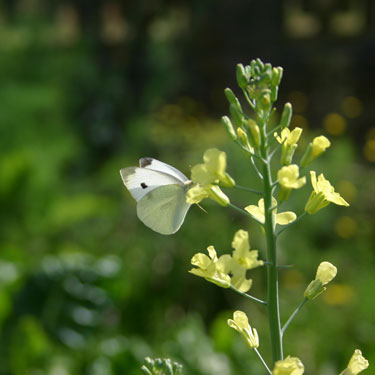
Cabbage white butterfly
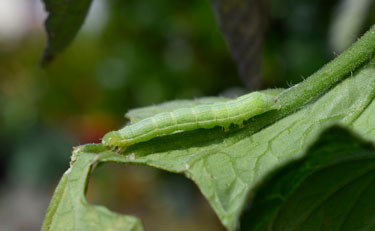
Green looper caterpillar
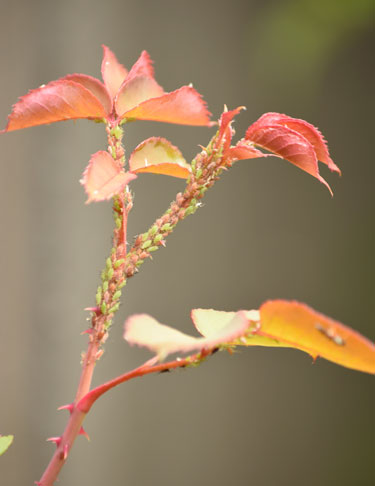
Aphid colony on rose shoot
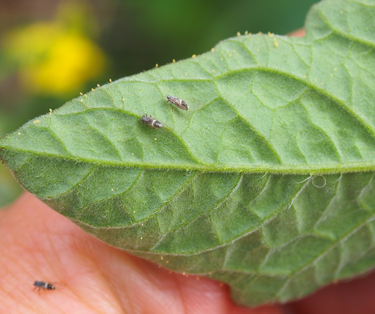
Tomato-potato psyllid
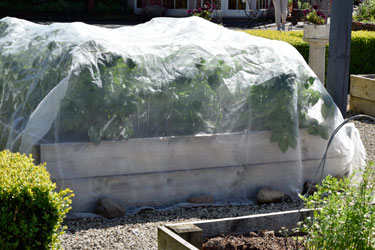
Fine mesh cover over potatoes to keep off tomato-potato psyllid


